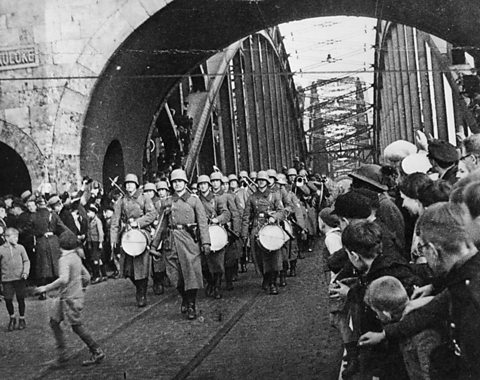Britainâs policy of appeasement
Definition of appeasement
Neville Chamberlain, the British Prime Minister, was keen to avoid war. He believed this could be achieved through the use of negotiation, agreements and diplomacy. His policy was to appease Hitler, which usually meant giving in to Hitlerâs territorial demands.
Examples of appeasement
It is suggested that this included Britain not âgetting toughâ on Germany when it rearmed and invaded the Rhineland, and its invasion of Czechoslovakia.

The most famous example of appeasement is Chamberlain signing the Munich agreement which resulted in Germany taking the Sudetenland from Czechoslovakia. Chamberlain hoped this would be the end of Hitlerâs demands, although other politicians such as Churchill warned otherwise.
Popularity of the policy of appeasement

Chamberlain was popular, and was welcomed by cheerful crowds who believed he had avoided war. He was invited by the King and Queen to Buckingham Palace.
Appeasement was initially popular because:
- people wished to avoid conflict - memories of the Great War and its suffering were still present
- Britain in the 1930s was struggling with the impact of the Depression, and so the country could not afford another war and heavy rearmament
- many felt that the Treaty of Versailles had been too strict, and that Germany had a right to try and regain lost lands and to rebuild its weakened forces
War breaks out â September 1939
Due to the Nazi-Soviet Pact, Hitler knew that the Soviet Union would not stand in his way over Poland. German forces crossed into Poland on 1 September 1939.

Britain had earlier given assurances to Poland and so sent an ultimatumA final demand made by a person, group of people or state during a dispute, which if rejected, may lead to a breakdown of relations or excessive force. that stated that Germany had to withdraw from Poland. Britain received no reply and so on 3 September 1939 Chamberlain declared that Britain was at war with Germany.